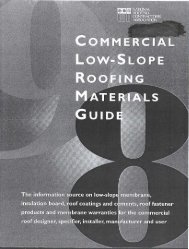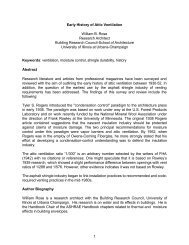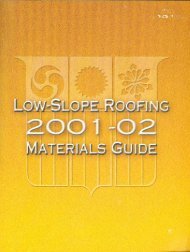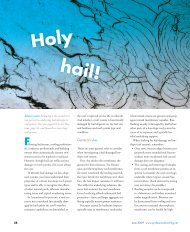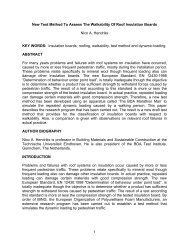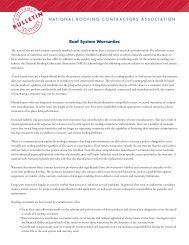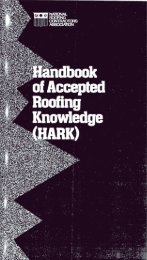1 Aging and Hail Research of PVC Membranes Frank J. Foley, Jim ...
1 Aging and Hail Research of PVC Membranes Frank J. Foley, Jim ...
1 Aging and Hail Research of PVC Membranes Frank J. Foley, Jim ...
Create successful ePaper yourself
Turn your PDF publications into a flip-book with our unique Google optimized e-Paper software.
For 1997 (the only year posted on the web site), the mean monthly UV index for Arizonacalculates to 6.25 while the mean index for Minnesota is 3.25. Within the total average<strong>of</strong> all 13 states in this study (Item b in Table 3) ro<strong>of</strong>s in Arizona were aged an additional32.7%, while ro<strong>of</strong>s in Minnesota were made 30.9% younger.Arizona WeightingMinnesota Weighting(6.25 – 4.71) / 4.71 = + 32.7% (3.25 – 4.71) / 4.71 = - 30.9 %Thus, the age <strong>of</strong> all ro<strong>of</strong> samples taken from Arizona increased by 32.7%, <strong>and</strong> the age<strong>of</strong> Minnesota samples were reduced by 30.9%. Going forward, test results thatreference “UV age” or “UV factored age” are a result <strong>of</strong> this method <strong>of</strong> factoring.This crude method <strong>of</strong> UV factoring makes the assumption that a month's aging processfor a July Arizona ro<strong>of</strong> is 10 times faster than a January Minnesota ro<strong>of</strong>. No empiricalsupport for this consideration exists. Consistent observations <strong>of</strong> sun <strong>and</strong> heat exposureare the two primary weathering agents <strong>of</strong> <strong>PVC</strong> ro<strong>of</strong> aging. Southern U.S. <strong>PVC</strong> ro<strong>of</strong>sage more rapidly than northern ro<strong>of</strong>s. Regardless, as depicted in the next table, this“factoring” bias among the samples is fairly uniform in impact. Underst<strong>and</strong>ably the ro<strong>of</strong>samples among the four manufacturing groups were evenly dispersed, both in age <strong>and</strong>geography.<strong>Aging</strong> by Manufacturing GroupsTable 4 reports four distinct manufacturing groups (group identification here is A, B, C,& D) were sampled with mean age <strong>and</strong> mean UV-factored age.GroupIDNo. <strong>of</strong>SamplesMean Age<strong>of</strong> Samples(Years)FactoredUV Age(Years)DIFF %A 20 5.79 6.08 0.29 5.01%B 21 4.30 4.74 0.44 10.23%C 25 4.95 5.42 0.47 9.49%D 21 5.83 6.05 0.22 3.77%87Table 4: Four manufacturing groups, mean <strong>and</strong> UV factored ageNotably, the newest <strong>of</strong> the four manufacturing groups was Group B with an average age<strong>of</strong> 4.3 years. This group had the greatest amount <strong>of</strong> UV factoring - an additional .44years (about 5 months). If a false-positive bias in aging exists due to the factoringmethod (if a July Arizona ro<strong>of</strong> does not age faster), then Group B will receive thegreatest percentage <strong>of</strong> false bias. In contrast, the oldest <strong>of</strong> the four groups (group Dmean exposure <strong>of</strong> 5.83 years) received the least amount <strong>of</strong> factoring - an additional .22years (about 2-1/2months).8




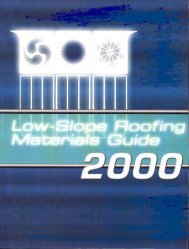
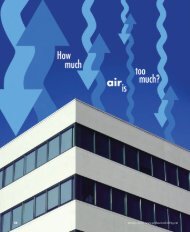
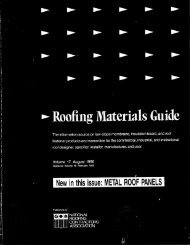
![Wm] - National Roofing Contractors Association](https://img.yumpu.com/36696816/1/190x245/wm-national-roofing-contractors-association.jpg?quality=85)

